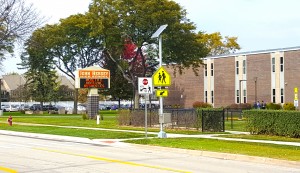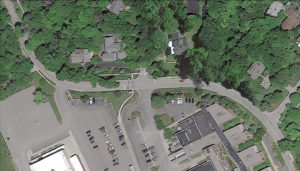Improving School Pedestrian Safety through Traffic Engineering Solutions

Stephen B. Corcoran, P.E., PTOE
By Stephen B. Corcoran, P.E., PTOE
Schools are among a list of destinations in which mid-block crosswalks can create unsafe and unpredictable situations for both pedestrians and vehicles. Increasing pedestrian safety while maintaining reasonable traffic flow, requires careful assessments of school parking lots, vehicular traffic on bordering roads, as well as, pedestrian foot traffic.
Rectangular Rapid Flash Beacon (RRFB)

Rectangular Rapid Flash Beacons (RRFB)
Rectangular Rapid Flash Beacons (RRFB) boost safety at unsignalized intersections and mid-block pedestrian crossings by raising driver awareness of pedestrians. RRFBs are activated by pedestrians with a push of a button trigger flashing signals instructing vehicles to stop while pedestrians are crossing.
Hersey High School
Hersey High School in Arlington Heights, Illinois wanted to improve a parent drop off and pick-up parking lot as well as enhance the safety of the 500 daily student crossings across a three-lane collector road.
After assessing the site, EEA redesigned the parking lot to direct exiting traffic away from the crosswalk and recommended the installation of a fence and landscaping to direct students to a single crossing point with a RRFB. The new crossing point consisted of a marked cross walk, advanced signage, signage at the crosswalk and RRFB facing both directions.
High Intensity Activated Crosswalk signals
High Intensity Activated Crosswalk (HAWK) signals, are hybrid traffic beacon devices used to assist pedestrians crossing busy streets. Like RRFBs, Hawk signals are activated by pressing a button, but also include highly visible overhead lights, similar to traditional stop lights. The initial flashing yellow lights alert drivers that pedestrians have activated the signal, then quickly turn solid, warning drivers to make a complete stop. When the lights turn red, pedestrians receive a white “walk” sign signaling they may proceed across the intersection. Following the countdown, flashing red lights appear telling drivers that if the road is clear, they may proceed with caution. Following the activation, the beacon goes dark and traffic continues as normal. Pedestrian hybrid beacons provide a safer crossing alternative than traditional crosswalks, especially in mid-block locations, and since devices require manual activation, drivers experience minimal delays.
Highland Park High School
Highland Park High School and the City of Highland Park were seeking a solution for pedestrians to safely cross a street with several curves along the east side of the school’s campus. The road’s limited sight distance meant an RRFB would not provide enough warning to approaching vehicles. Instead, EEA recommended a HAWK signal because it requires all vehicles to come to a complete stop before pedestrians can cross the street to address the challenges presented by the winding road, EEA also implemented advanced flashing signs on the approaching routes to further warn drivers.
Interested in determining if a RRFB or a Hawk signal is right for your school project? A comprehensive traffic study identifying existing school circulation patterns, volumes, and needs can help determine how to increase safety for both drivers and pedestrians with these devices or other solutions

